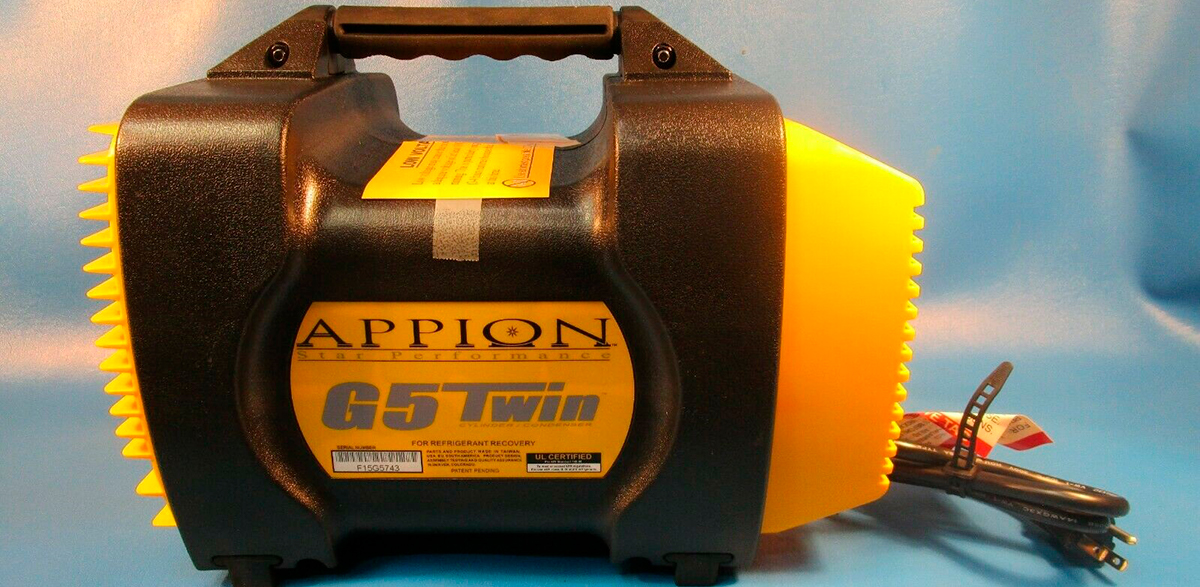
A refrigerant recovery machine, as the name indicates, is an appliance intended to collect refrigerant from cooling equipment (like an air conditioner, coolant, etc.), which is an important part of their maintenance. The best refrigerant recovery machine must be safe for your cooling device, easy to use, and have a decent pressure level. Thus, better look for a unit that has at least 500 PSI (pounds per square inch) of pressure.
Usually, technicians use this device before proceeding to the air conditioner repair. However, in fact, the refrigeration recovery system can be used by anyone (read the instructions on how to use this appliance in the Buyer’s Guide part). The AC units are especially relevant for those who live in a hot climate and use cooling appliances on a daily basis.
Such machines come in various types, ranging from modern devices with touchscreens to vintage ones with analog interfaces. Some of them are portable enough to be stored in the trunk of your car, while others are so big that they can only be stored in your garage.
A refrigerant recovery machine is a costly device, and when you acquire one, you want it to work as long as possible. And our top can narrow things down for you, helping you find a reliable and robust machine.
Refrigerant Recovery Machine Reviews
Robinair RG3 — Best Portable Refrigerant Recovery Machine

The most appealing aspect of this model is its portability: it’s so compact (12.5 x 6.5 x 9.5 inches) and lightweight (18 pounds) that it can be easily lifted with one hand (the unit has a carrying handle). So, you can consider it as the best refrigerant recovery machine in terms of portability as it will be challenging to find a more compact one.
This model is expensive since it has quite a broad functionality. First of all, it recovers liquid and vapor via an oilless compressor. It also has an automatic shut-off feature that helps prevent the unit from reaching critical levels of pressure. In addition, the machine is compatible with all the most popular types of refrigerants (like CFC, HFC, and others).
This recovery machine HVAC is a well-constructed device that has a powerful fan and durable body, made of dense plastic. It has two valves, two gauges, and a Power on/off switch.
During the tests, I’ve noticed that this model recovers about 2 pounds in around 35 minutes. So, as for its size, the machine works reasonably fast. It will work only for residential air conditioners that weigh no more than 30 pounds. The recovery process for large systems will be extremely time-consuming.
As a portable refrigerant recovery machine, this model is excellent. However, I don’t think that it will serve you for a long time if you are planning to use it very often.
Pros
- It features an efficient cross-flow design.
- The fan inside is small, so it works quietly.
- The Robinair RG3 comes equipped with a filter dryer that does thorough work in adsorbing contaminants.
Cons
- Only a one-year warranty for such a costly unit.
- The kit does not include an adapter for an automotive hose, so you will have to buy it separately.
Overall rating: 9/10
Appion G5TWIN
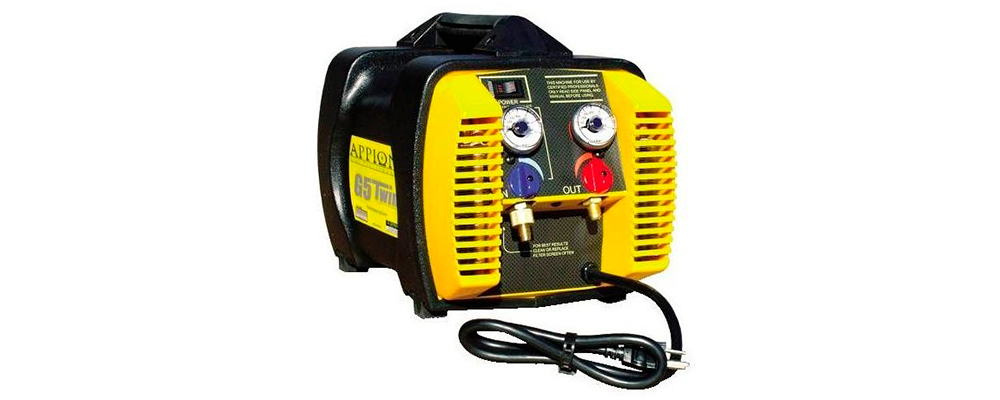
This residential model is lightweight (24 pounds), small (13.75 x 10.3 x 9.4 inches), and is easy to use. It’s equipped with a 0.5 HP heavy-duty motor that runs at 3000 RPM. It has a two-valve design with two pressure gauges and comes in a rugged case with a soft gripping handle. The crankcase is sealed, so no refrigerant can get to the bearing.
The model functions as a freon recovery machine as well as handles other common refrigerants, including R410A, R-134a, and R-407C (works with both liquid and vapor). The recovery rate of this unit is 0.62 pounds of vapor per minute and 10.36 pounds of liquid per minute. The automatic shut-off feature is provided.
Thanks to double cylinders and double condensers, the tool provides quick recovery and creates high airflow even despite its dimensions. The turbine fan inside keeps the unit cool even under intense working conditions. Because of this, the machine appeared to be louder than I had anticipated.
The manufacturer presents this A/C recovery machine as the one that can be purchased for industrial and/or commercial demands. Still if you are an HVAC technician, you will most likely need a more multifunctional model.
Pros
- Thanks to the modular construction of this unit, it can be easily disassembled. Hence, it will be easy to make a replacement of the broken parts.
- The ball bearing provides a high level of torque.
- I didn’t notice any clog-prone orifices. This ensures that the unit is safe from future clogging-related maintenance issues.
Cons
- The manufacturer provides a warranty only for those parts that come in contact with the refrigerant.
- The valves are made of poor-quality plastic and will probably break easily.
Overall rating: 8/10
Fieldpiece MR45
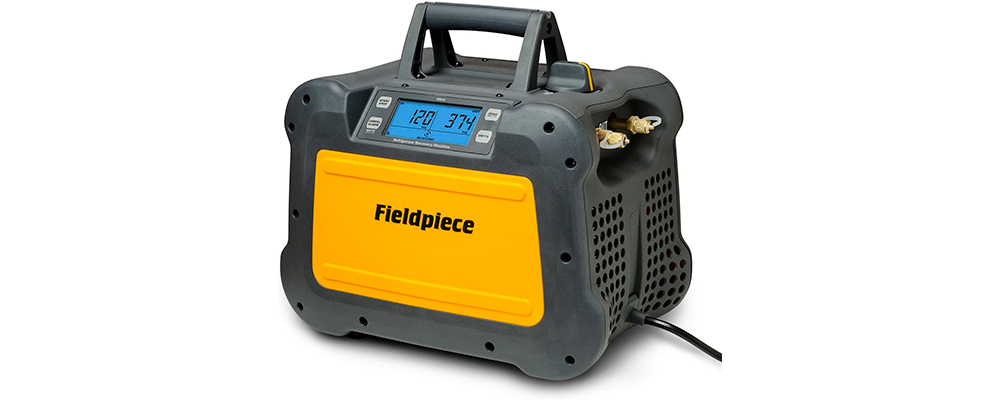
This HVAC recovery unit is controlled by 4 buttons (Start/Stop, Cancel/Alarm, Zero, and Units) and has a large informative LCD display. On this display, you can see not only the pressure level, but also information about the motor status since the MR45 is a smart unit, equipped with an inbuilt diagnostics feature. The display also has a blue backlight, making it easy to see all information on it in the dark.
This recovery machine has one of the fastest vapor recovery rates. Thus, it can possibly be the best HVAC recovery machine in terms of speed. The reasons for that are a powerful motor (1 HP) that runs at 3300 RPM and an oversized condenser. So, as you can see, overloading this car will be difficult.
An oilless twin cylinder compressor is made of ceramic which inspires durability and reduces friction. The unit itself measures 9.8 x 13.5 x 14.8 inches, weighs just 22 pounds, and has a carrying handle with built-in cord storage.
Pros
- The machine is water-resistant (IP24) and can withstand the direct flow of water.
- It has a voltage drop protection system, so you shouldn’t worry even when voltage drops down to 95 VAC.
- The unit automatically reduces the motor’s speed to prevent liquid slogging.
Cons
- The glossy display is poorly visible under the daylight.
- The words on display tend to flicker for no apparent reason, making them difficult to read.
Overall rating: 9/10
Robinair RG6
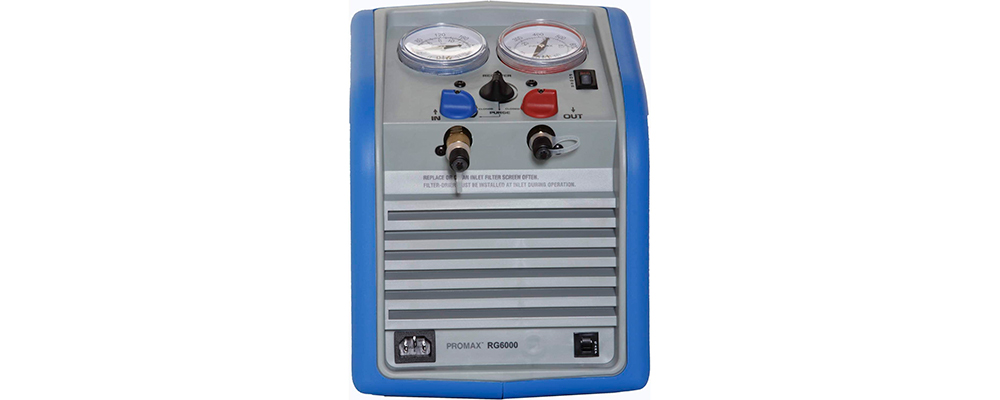
The present model from Robinair works with CFC, HFC, and HCFC refrigerants. It’s supplied with a 0.75 HP motor and is capable of recovering liquid and vapor. Twin-cylinder construction and large condenser provide superior cooling performance and fasten the recovering cycle. The smaller and less expensive model from the same series (the RG3) has a single cylinder and smaller condenser. So, as you can see, the RG6 is a good upgrade.
The design is intended to resist rigorous use and adverse weather conditions such as snow, rain, and severe temperatures. Hence, it’s suitable for both industrial and commercial applications. This machine for AC recovery weighs 33 pounds and is sized at 17 x 9 x 12 inches. The gauges are large and easy to read. In terms of control, there are 3 valves and a Power switch. The RG6 shuts off automatically if the pressure level rises above 550 PSI. The machine works quietly and doesn’t generate a lot of heat during operation.
Pros
- The unit features a self-purge manifold, which saves your time on unit maintenance (it works by cleaning the hoses from freon without removing air from the recovery tank).
- The model uses the IEC connector and power cord that provides a high level of protection from electrical shock.
- It consumes 1265W at full load, which is relatively low when compared to other similar models.
Cons
- This model comes without hoses and adapters for a car AC system.
- The cord connects to the front part of the machine. Most other AC recovery units have it on the back since the cord bothers you to work with the machine when it’s located on the front.
Overall rating: 8/10
Vivohome VH471
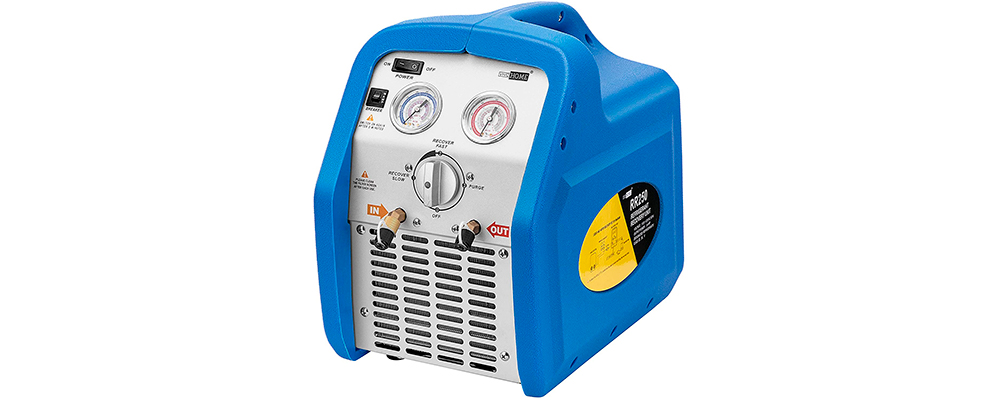
The current model is probably the best automotive AC recovery machine for home use on our list since it has been designed specifically for this purpose, with convenience and ease of use in mind. There is a 3-point (Slow, Fast, Purge) valve, Power and Breaker switches, and two gauges. When the pressure value exceeds 558 PSI, the auto-stop function activates. The machine comes with a filter drier for filter purification.
The fan for cooling the machine down is large (it occupies the entire rear panel of the unit). The weight makes 31 pounds, and the size is 15.7 x 14 x 9.8 inches, so this model is easy to transport. It also has an ergonomic carrying handle.
Pros
- The machine’s bottom has four watertight feet that elevate it above the surface, so you won’t have to worry about setting it on a wet area.
- The fan automatically starts to dissipate heat more intensively under intense working conditions.
- The inlet port has a filter screen that prevents contaminants from entering the machine’s inner parts.
Cons
- When the job is finished, it must be manually switched off, and there is no signal that the recovery cycle has ended. So, you have to monitor when the pressure level reaches zero constantly.
- It doesn’t come with all the necessary hoses.
Overall rating: 8/10
Mahle ACX2280
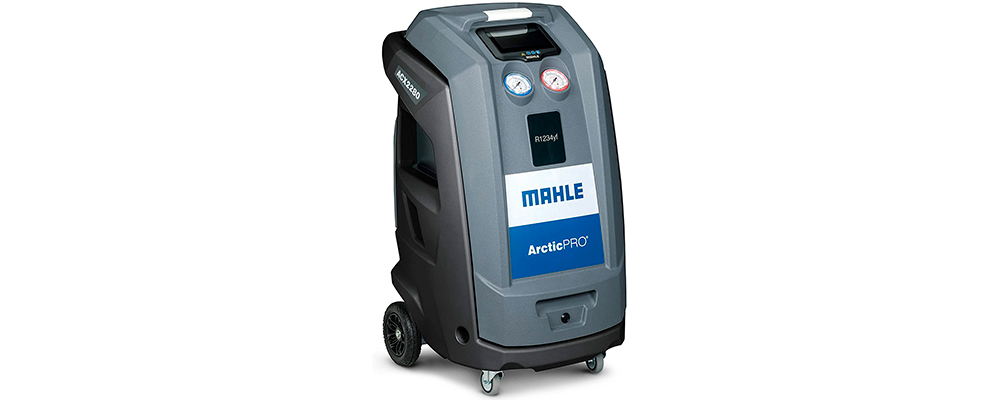
The ACX2280 is not among those HVAC recovery machines to have at home for basic needs. It’s a very expensive unit, but the abundance of high-tech features (for example, an automatic weighing system that allows you to know the exact amount of the recovered oil) totally justifies its price.
This HVAC recovery machine has a large 7-inch touch screen that is as easy to operate as a regular tablet. There is also a bright LED light indicating the machine’s status that is visible from far away. Therefore, you won’t have to track the information on the screen constantly. It has a hinged door that makes it easy to get to the machine’s internal components for repair.
The model is heavy (217 pounds) and large (47 x 29 x 29 inches), so it can hardly be lifted by a single person. However, it’s equipped with 4 wheels, enabling the user to roll it across the surface.
Pros
- It has an inbuilt refrigerant identifier.
- You can monitor the machine’s status and the recovery process via the SmartACX app on your phone (available for iOS and Android).
- The unit meets the SAE J2843 standard, which means that it can accurately recharge air conditioning systems and is safe to use.
Cons
- Visually, the machine seems rough and durable, but its exterior is actually made of plastic which is surprising for such a costly unit.
- The ACX2280 isn’t just heavy, it’s also very tall (47 inches), so the unit is really bulky.
Overall rating: 9/10
Buyer’s Guide
How does a Refrigerant Recovery Machine Work?
When the AC recovery machine is attached to the cooling unit, it creates pressure in order to suck the refrigerant out of it. When this process is completed, the device filters the refrigerant and stores it in a separate tank. After that, the machine cleans the system by vacuuming it in order to ensure that no moisture or air is left.
How to Use a Refrigerant Recovery Machine
The HVAC system and the recovery machine must be turned off before you proceed to work. The valves also should be closed before you begin.
Step 1. Connect a filter dryer to the inlet of the recovery machine.
Step 2. Connect the tank’s hose to the outlet of the recovery machine.
Step 3. Slowly open the liquid port of the recovery tank.
Step 4. Set the Recover/Purge valve to the Recover position.
Step 5. Open the output port.
Step 6. Open the liquid port on the manifold gauge set. It will initiate the liquid removal process. Make sure not to overfill the tank (most manufacturers do not recommend filling it for more than 80%). When the indicator on the machine shows 0 PSI, it means that the refrigerant has been removed.
Step 7. After the liquid has been removed, open the manifold vapor port.
Step 8. Connect the unit to the correct power supply (the one that is stated in your model’s manual).
Step 9. Turn the main switch into the On position. You should hear the fan running.
Step 10. Start the compressor by turning a corresponding switch on.
Step 11. Slowly open the input port.
Step 12. After the vacuuming process is finished, close all the ports.

My name is Brandon, and I’ve been interested in cars since I was a kid. I got a bachelor’s degree in Automotive Technology and worked in a private car workshop. I have two cars that have been completely upgraded with my own hands. So I successfully put all my knowledge into practice.
Last update on 2025-12-24 / Affiliate links / Images from Amazon Product Advertising API





